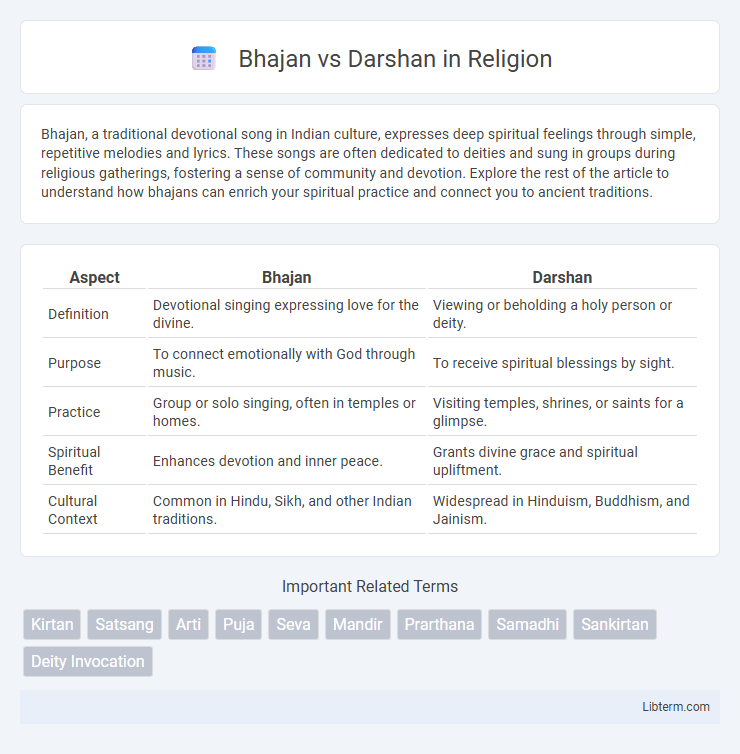Bhajan, a traditional devotional song in Indian culture, expresses deep spiritual feelings through simple, repetitive melodies and lyrics. These songs are often dedicated to deities and sung in groups during religious gatherings, fostering a sense of community and devotion. Explore the rest of the article to understand how bhajans can enrich your spiritual practice and connect you to ancient traditions.
Table of Comparison
| Aspect | Bhajan | Darshan |
|---|---|---|
| Definition | Devotional singing expressing love for the divine. | Viewing or beholding a holy person or deity. |
| Purpose | To connect emotionally with God through music. | To receive spiritual blessings by sight. |
| Practice | Group or solo singing, often in temples or homes. | Visiting temples, shrines, or saints for a glimpse. |
| Spiritual Benefit | Enhances devotion and inner peace. | Grants divine grace and spiritual upliftment. |
| Cultural Context | Common in Hindu, Sikh, and other Indian traditions. | Widespread in Hinduism, Buddhism, and Jainism. |
Introduction to Bhajan and Darshan
Bhajan is a devotional song or hymn in Indian spiritual traditions, dedicated to expressing love and reverence for a deity, often sung in groups during religious gatherings to create a shared spiritual experience. Darshan refers to the sacred act of beholding a deity, saint, or sacred object, believed to convey spiritual blessings and deepen the devotee's connection with the divine. Together, Bhajan and Darshan serve as complementary practices that enhance devotion and facilitate personal spiritual growth in Hindu worship.
Historical Origins of Bhajan and Darshan
Bhajan originated in ancient India as a devotional song form associated with Bhakti movement saints like Kabir and Mirabai, expressing deep spiritual emotions through Sanskrit and regional languages. Darshan, rooted in Hindu philosophy, refers to the act of beholding a deity or guru, symbolizing a visual and spiritual connection that dates back to Vedic traditions. Both Bhajan and Darshan evolved as integral practices in Hindu worship, fostering personal devotion and communal spirituality.
Defining Bhajan: Meaning and Significance
Bhajan is a devotional song originating from Indian spiritual traditions, expressing love and reverence towards deities, typically performed in repetitive melodies to induce a meditative state. It holds significant cultural and religious importance by fostering communal harmony and spiritual upliftment during religious gatherings and festivals. Bhajans serve as a medium for emotional expression and spiritual connection, contrasting with Darshan, which primarily involves the visual experience of seeing a holy person or deity.
Understanding Darshan: Concept and Importance
Darshan represents the profound spiritual experience of beholding a deity or a revered person, symbolizing a direct connection to divine energy and blessings. This practice holds immense importance in Hinduism, as it cultivates devotion, facilitates grace reception, and deepens the devotee's faith and spiritual insight. Unlike Bhajan, which involves devotional singing, Darshan centers on visual communion, making it a vital element of worship and spiritual practice.
Key Differences Between Bhajan and Darshan
Bhajan is a devotional song expressing love and reverence towards a deity, primarily focusing on musical worship and emotional connection, while Darshan refers to the act of beholding or viewing a deity or holy person, emphasizing visual and spiritual experience. Bhajans involve singing with instruments, often performed in groups, enhancing collective devotion, whereas Darshan is usually a silent, personal encounter that fosters a direct divine connection. The key difference lies in Bhajan's auditory and participatory nature versus Darshan's contemplative and visual spiritual significance.
Role of Bhajan in Spiritual Practice
Bhajan plays a crucial role in spiritual practice by fostering deep emotional connection and devotion to the divine through repetitive chanting and soulful melodies. This practice enhances mindfulness, cultivates inner peace, and facilitates a personal experience of spirituality beyond intellectual understanding. Bhajan's vibrational energy aligns the mind and heart, promoting spiritual growth and a heightened sense of unity with higher consciousness.
Significance of Darshan in Devotional Life
Darshan holds profound significance in devotional life as it embodies the direct visual connection between the devotee and the divine, fostering an intimate spiritual experience. This sacred sight is believed to confer blessings, purify the soul, and deepen faith, making it a pivotal practice in Hindu worship rituals. Unlike Bhajan, which involves devotional singing and chanting, Darshan emphasizes presence and visual communion, strengthening the devotee's spiritual bond with the deity.
Rituals and Traditions: Bhajan vs Darshan
Bhajan rituals center on devotional singing and musical worship, where participants engage in collective chanting to invoke spiritual connection and express reverence to deities. Darshan involves the ritual viewing of a deity or spiritual guru, emphasizing visual and contemplative interaction, where devotees seek blessings and spiritual insight through sight. Both practices uphold traditional customs, with Bhajan fostering auditory devotion and communal participation, while Darshan emphasizes silent reverence and personal spiritual experience.
Impact on Community and Individual Devotion
Bhajan fosters community bonding through collective singing and shared spiritual experiences, strengthening social cohesion and cultural identity. Darshan provides a personal, transformative encounter with the divine, deepening individual devotion and spiritual insight. Both practices complement each other by nurturing communal unity and personal faith growth within Hindu traditions.
Conclusion: Choosing Between Bhajan and Darshan
Choosing between Bhajan and Darshan depends on individual spiritual aspirations and the desired form of devotion. Bhajan, as a form of devotional singing, fosters emotional connection and collective participation, enriching one's inner experience. Darshan offers a visual and contemplative engagement with the divine, providing a direct spiritual presence that nurtures devotion through sight and reverence.
Bhajan Infographic

 libterm.com
libterm.com